#9 Mind The Gap
Anxiety is a bitch
"Anxiety = powerlessness x uncerainty"
Chip Conley
Dan Nicholson introduced me to this quote a couple of years ago. In the CCA and in his book, Rigging The Game, he expands: using the distributive property he masterfully extrapolates this equation to finance:
(Financial) anxiety = (financial) powerlessness x (financial) uncertainty
Math is cool like that.
(x) anxiety = (x) powerlessness x (x) uncertainty.
Replace x with relationship, parenting, fitness, or anything else you can think of and it will likely still ring true.
So if you're in a hole of anxiety, how do you get out?
Stop Digging.
Your brain is going to bias positive action; it's going to start looking for things to do to actively gain more power and more certainty! Well, I'm gonna say "slow your roll homie." First, you have to decide that you want to get out. Assuming that you do, the next thing to do is to stop digging. In other words, you have to understand what is putting you deeper in the hole and eliminate those things before trying to climb out.
Otherwise, you're just pushing on the gas pedal and the brake at the same time. Or, as Dan would say, watering the weeds you're trying to get rid of.
Digging out of the "anxiety hole" means 'stop doing things that create more powerlessness or uncertainty" Duh. Wanna know what creates the greatest increase in powerlessness and uncertainty?
... when reality does not meet your expectation.
Mind The Gap(s).
The wider the gap between reality and your expectation of reality, the greater the feeling of powerlessness and uncertainty.
There are three primary forces that wedge themselves between your monkey brain and contact with reality (and one of them is another gap! gasp).
Force 1: Brain Sludge
Driver: Outcome Bias
Outcome bias is judging decisions and people based on the outcome instead of logic, evidence, and reasoning behind the decision. This is cognitively lazy and it's dangerous. Because a bad decision can have a positive outcome and a good decision can have a negative outcome it's easy to mistake a poor decision maker for being competent and a good decision maker for being incompetent. And, because you are not examining the logic, reasoning, and evidence behind the decision when reality fails to meet the narrative you've created, you cannot learn from it.
Outcome bias leads to a fabricated experience. Fabricated experience leads to a convenient narrative. Convenient narratives lead to a massive gap between reality and expectation. This one goes deep, I cover it here. (Watch the video if you get a chance)
Force 2: Dogmatism
Driver: A Dogmatic Orientation (all-or-nothing thinking)
A dogmatic orientation processes the world in absolutes and certainties. Yet another byproduct of being cognitively lazy. The world is not absolute or certain, counterintuitively, certainty comes from accepting uncertainty and processing the world from a scientific orientation; thinking in risks and probabilities. When you think in terms of risks and probabilities you can develop the tools to drive the probability of favorable outcomes up and risks down.
This one also goes deep, you can read (or watch) the deep dive here. Or, be cognitively lazy and don't.
Force 3: The Intention - Intervention Gap
Driver: Disconnect From Reality (in regards to self)
Another gap! The intention-intervention gap is the gap between what you say you're going to do or what you think you are doing and what you actually do.
To fully understand and appreciate this, you'll have to have a conceptual understanding of system reliability. System reliability is the probability that you get the outcome you expect from a system; if system reliability goes up, the gap between expectation and reality goes down. Said another way, if you understand system reliability, you gain some power over your anxiety level.
The reliability of a system is a product of the reliability of the components of the system. (That's very important, see the overview and math here)
Once you start to grasp system reliability it starts to become apparent that...
...The Least Reliable Component In Every System Is The Human ...
...and we consistently refuse to account for it.
Let me give you an example:
Let's say that you do all your homework, study everything you can find about health and fitness, and hire the best experts. Then you come up with a plan and what you believe to be a reasonable expectation for that plan.
The Plan:
Eat 2,5000 calories a day for 6 weeks
Exercise 60 minutes a day for 6 weeks
Expectation:
Lose 1lbs a week, or 6lbs over 6 weeks
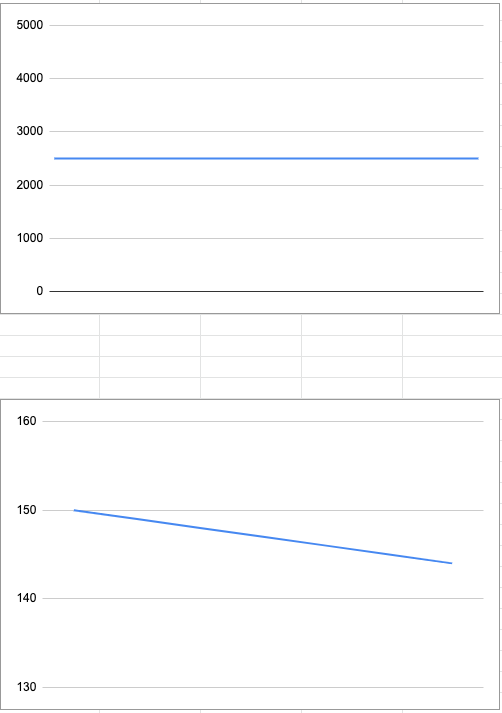
Your plan (2,500 calories a day) and your expectation (lose 6 lbs) are represented by the blue trend line. This is where a lazy monkey brain starts to glitch.
After 6 weeks of following the plan, you're 151.5lb and ready to have a breakdown. The gap between expectation and reality is about to hijack your monkey mind again.
The red line represents reality (1.5lb gain over 6 weeks):
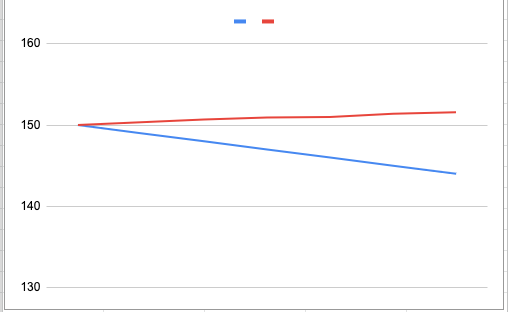
Important note:
Gaining 1.5 lbs over 6 weeks is not the end of the world. The danger lies in the gap between expectation and reality. 1.5 over baseline is fine, 7.5 over expected is a much larger gap and will create an exponentially greater feeling of powerlessness and confusion.
Okay, back to your monkey mind.
It's thinking:
"Ugh. How can this be? I did all the research. I put together a great plan. If this plan doesn't work nothing will work for me. Maybe I have thyroid issues?"
Eventually, you'll throw this plan in the stack of plans, strategies, technologies, and tools that "don't work". As the stack of "plans that don't work" grows so does the feeling of powerlessness and uncertainty.
Wait. One. Gosh. Darn. Moment.
I need to tell you something.
Your monkey brain is cognitively lazy. It believes that it has learned the following:
This plan:
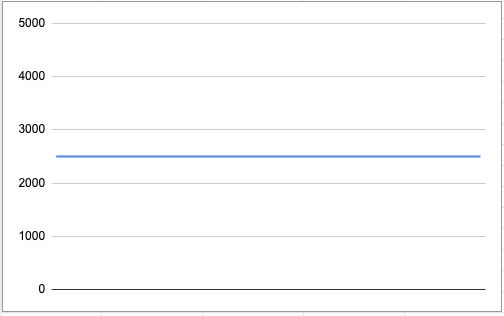
2,500 calories a day
for 6 weeks
Leads to this reality:
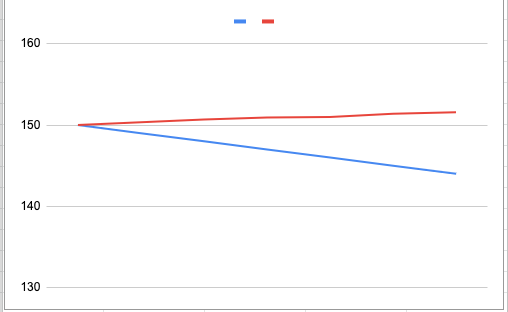
1.5lbs gained
Hold on, lazy monkey mind. Something is missing.
The blue represents the plan and the expectation, respectively. Both a plan and expectations are narratives about the future. In theory, this was a well-researched and reasonable narrative, but it is a narrative nonetheless.
The red represents reality. Reality is created by what's been done. The science of hindsight.
In other words, that red line is not a byproduct of the plan you put in place, it's a byproduct of what you have actually done. Which is, of course, mysteriously missing from the monkey brain's calculus.
There should be a red line in the top graph as well, a line made up of what actually happened. Let's harness the power of hindsight and take a peek:
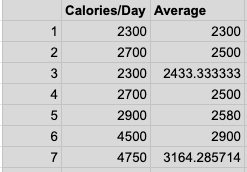
Looks like for 5 days out of the week you worked really hard, practiced self-control, and came very close to your target, averaging 2580 calories a day. Then, on the weekend you probably went out, had some drinks, and gave yourself a little leeway. But still, 5 days out of every 7 you were ON IT. That's good, right? (A better question would be: I should still get the outcome I expect, right?)
5 out of 7 is a hair over 71%.
I dunno... if your car only started 5 out of every 7 or 71% of the time you tried to start it or your phone only worked 5 out of every 7 or 71% of the time you tried to use it.. would you consider that good? Would you get the outcome you expected most of the time?
You'd either realize that you need to change your car or phone immediately or you would adjust your expectations accordingly, methinks.
Funny, your monkey brain didn't make the same adjustment for your own behavior.
No wonder it feels like nothing ever works.
I digress...
Day 7 comes and, because your brain doesn't fully register the reality, you feel like you're doing pretty good and repeat the same thing, on average for 5 more consecutive weeks.
Wanna know what that looks like?
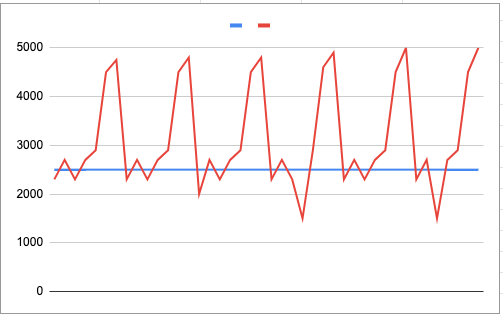
This changes things. The blue line represents what your monkey brain believed you were doing because it was the plan. The red line represents your actual behavior.
The gap between the two represents the gap between reality and expectation.
That, my friend, is the intention-intervention gap.
Understand: The idea is not to lose more weight faster or make more money faster, or whatever it is that you are trying to do; it's to close the intention-intervention gap so that you can actually gauge the efficacy of your plans. Until you do that, you will not hold on or power over reality (which is where we live, whether we like it or not)
Just so we are clear:
This plan/strategy/program:
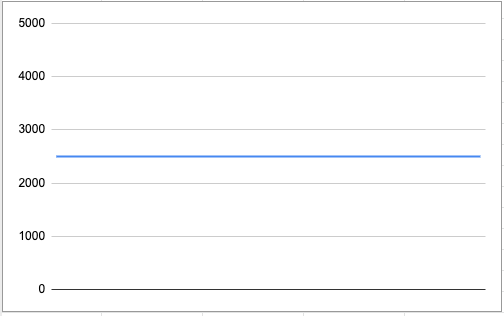
2500 calories day
60 min exercise
Every day for 6 weeks
Did not lead to this:
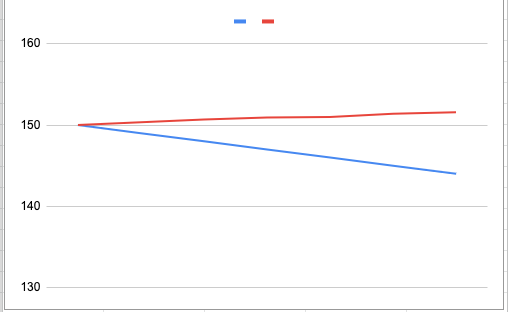
1.5 lbs gained over 6 weeks
This behavior did:

Reality did not meet expectations because your expectation was based on a plan and was never adjusted based on actual behavior. Reality tells us about your behavior, so the further your deviation from the plan, the less the results reveal about that plan (or tech, strategy, etc).
Only when your behavior matches the plan with 100% consistency can you gauge the efficacy of the plan and then gauge and adjust accordingly.
Because your monkey mind is lazy AF, it often fails to make this connection leaving you up "shit creek" without a paddle, forever cycling through plans, strategies, and programs.
Reality will continue to fail to meet expectations and you will continue to find yourself neck-deep in anxiety unless you take your brain back.
Pay attention to the gap between what you think is happening and what is actually happening.
You may not like that you gained 1.5 lbs during a time that was dedicated to dieting. I get it. But by not being a cognitive bum and not making "sense" of it quickly, you have given yourself power over the future outcome by mapping your reality to your behavior.
Close the intention-intervention gap, close the reality-expectation gap.
Welcome to the real world.
There's less anxiety here, I think you'll like it.
Nic
PS. This is not a suggestion to be more dogmatic or militant about your plans. It's a suggestion to live in reality. Oftentimes the best way to get power over the outcome is not to be more strict with your behavior but to have a more reasonable plan.
You can change the plan, you can change your behavior or you can change both. What’s important is that the gap between the two grows smaller.
